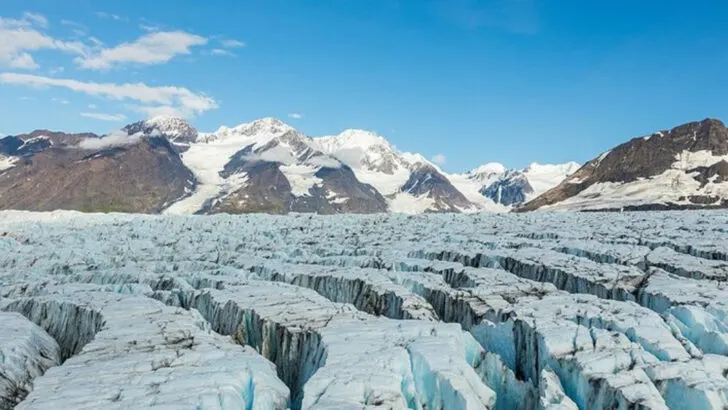Alaska is a land of extremes — towering mountains, endless forests, and a sky that shifts from brilliant sunlight to mesmerizing auroras. Every corner of this vast state holds surprises that highlight why it’s called the Last Frontier.
From natural wonders to quirky records and unique wildlife, these 13 fun facts reveal the charm, scale, and spirit of Alaska in ways most travelers might never expect.
Alaska’s Coastline
More than just a snow-covered expanse, Alaska boasts a coastline longer than all other U.S. states combined. Its intricate tapestry of fjords and bays stretches over 6,640 miles, a testament to the state’s majestic natural architecture.
Marine life thrives in these waters, providing a sanctuary for seals, otters, and countless fish species. From the rocky cliffs of the Kenai Peninsula to the tranquil waters of the Inside Passage, Alaska’s shoreline is a stunning marvel.
This coastline isn’t just about beauty; it’s a vital lifeline for communities and ecosystems, showcasing the state’s profound connection to the sea.
Denali’s Majestic Peak
Soaring at 20,310 feet, Denali dominates the Alaskan landscape as North America’s tallest peak. This colossal mountain, formerly known as Mount McKinley, attracts climbers from around the world.
Its snow-capped summit and rugged terrain embody the wild beauty of Alaska. Denali isn’t just a mountain; it’s a symbol of strength and endurance.
Surrounding it is a vast national park teeming with wildlife, including grizzly bears and caribou. Each year, adventurers and nature lovers flock to this iconic site, eager to experience its awe-inspiring presence.
Millions of Lakes
With over 3 million lakes, Alaska is a freshwater paradise. These shimmering bodies of water vary in size, from small ponds to sprawling Lake Iliamna.
Glacial melt and abundant rainfall feed these lakes, creating diverse ecosystems filled with fish and other wildlife. Their beauty is matched only by their utility, serving as vital resources for local communities.
These lakes are more than just picturesque vistas; they are integral to the Alaskan way of life, supporting both recreation and subsistence activities. Each lake tells its own story, a testament to nature’s bounty.
Winter Darkness in Barrow
In Barrow, now known as Utqiaġvik, winter brings an eerie beauty as darkness envelops the town for 83 continuous days. This phenomenon, known as polar night, offers a unique experience of the Arctic.
Residents adapt to the lack of sunlight with community activities and vibrant cultural traditions. Despite the darkness, the town remains lively and welcoming.
For visitors, this endless night provides an excellent opportunity to witness the northern lights, dancing across the sky in shimmering hues. It’s a magical spectacle that captivates the imagination and warms the soul.
Extreme Geographic Points
Alaska holds the unique distinction of containing the northernmost, westernmost, and easternmost points in the U.S. While Point Barrow marks the farthest north, the Aleutian Islands extend the state westward, crossing the 180-degree meridian.
Interestingly, this geographical anomaly means that Alaska is also the easternmost state, reaching into the Eastern Hemisphere. These extremes emphasize Alaska’s vastness and diversity.
This geographical curiosity adds to Alaska’s mystique, highlighting its vast expanse and unique global position. Visitors are constantly reminded of the state’s unparalleled natural diversity.
Glacier Paradise
Home to more than 100,000 glaciers, Alaska is a glacial wonderland. These ancient ice formations, like the famous Mendenhall and Hubbard Glaciers, shape the landscape with their slow, powerful movements.
Glaciers feed rivers and lakes, carving valleys and fjords as they advance and retreat. Each one is a living testament to Earth’s climatic history.
Adventurers and scientists alike are drawn to these icy giants, eager to explore their crevasses and study their impact on the environment. The ever-changing beauty of Alaska’s glaciers is both humbling and inspiring.
Sparse Population
Despite its enormous size, Alaska’s population is smaller than many U.S. cities. With just over 730,000 residents, the state offers a rare sense of solitude and space.
This sparse population density allows for undisturbed natural beauty and abundant wildlife. Communities are often tight-knit, fostering a strong sense of mutual support.
For those seeking serenity and a connection to nature, Alaska provides an ideal setting. The vast wilderness becomes a personal playground, offering endless opportunities for adventure and reflection.
Bear Population
In Alaska, bears outnumber people, underscoring the state’s untamed wilderness. Grizzlies, black bears, and polar bears roam freely, an integral part of the ecosystem.
These majestic creatures are often spotted fishing for salmon or foraging in the forests. Their presence is a constant reminder of nature’s dominance.
For wildlife enthusiasts, Alaska offers unparalleled opportunities to observe bears in their natural habitat. It’s an experience both thrilling and humbling, showcasing the raw power and beauty of the animal kingdom.
Moose in Anchorage
In certain areas of Anchorage, moose sightings are more common than encountering people. These gentle giants frequently wander through neighborhoods, often found munching on garden foliage.
Their presence adds a unique charm to city life, blending urban and natural worlds. Residents have grown accustomed to sharing their space with these iconic creatures.
Moose crossings are a regular part of daily life, adding a delightful unpredictability. It’s a testament to Alaska’s harmonious balance between human habitation and wildlife.
The Iditarod Trail
Spanning over 1,000 miles, the Iditarod Trail Sled Dog Race is a rigorous test of endurance and skill. This legendary race celebrates Alaska’s pioneer spirit and the bond between humans and dogs.
Mushers and their teams brave harsh conditions, traversing vast wilderness from Anchorage to Nome. It’s a tradition that honors the history of sled dog transportation.
Spectators from around the world gather to witness this thrilling event, where determination and teamwork reign supreme. The Iditarod is more than a race; it’s a celebration of resilience and adventure.
Alaska Purchase
In 1867, the United States acquired Alaska from Russia for $7.2 million, a price often described as a bargain. Known as “Seward’s Folly” at the time, this purchase added a vast and resource-rich region to the nation.
Critics initially questioned the decision, unaware of the treasures hidden within Alaska’s borders. Gold, oil, and natural beauty would later define the state’s value.
This historic acquisition has proved to be a strategic and economic asset, shaping Alaska’s identity and role within the United States.
Bald Eagles’ Dominion
In some Alaskan regions, bald eagles outnumber humans, symbolizing freedom and wilderness. These majestic birds are a common sight, soaring above the rugged terrain.
Their presence is a tribute to the state’s thriving ecosystems. Observers often spot them along coastlines and near salmon-rich rivers.
The abundance of bald eagles highlights Alaska’s commitment to wildlife conservation and habitat preservation. For bird lovers, visiting Alaska is a dream, offering unparalleled opportunities to witness these iconic raptors in flight.
Midnight Sun
In Barrow, the sun refuses to set for up to 82 days during summer. This phenomenon, known as the midnight sun, bathes the landscape in perpetual daylight.
Residents and visitors alike enjoy extended outdoor activities, from hiking to fishing, under the never-ending sun. It’s a magical time of year, filled with energy and vitality.
Experiencing the midnight sun offers a surreal glimpse into Alaska’s unique natural rhythms. It’s an extraordinary spectacle that defies conventional day-night cycles, filling the spirit with wonder.

